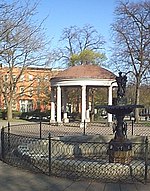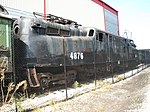Hollins Market, Baltimore

Hollins Market is a neighborhood in the Sowebo area of Baltimore. It takes its name from the Hollins Market, the oldest public market building still in use in Baltimore City, which is located in the heart of the neighborhood. Like the adjacent neighborhood Pigtown, Hollins Market has long been considered one of Baltimore's most promising neighborhoods because of its proximity to University of Maryland, Baltimore Medical Center, the Interstate 95 business corridor, Camden Yards, Ravens Stadium, the Inner Harbor, and Downtown Baltimore. Major construction projects such as the University of Maryland Biopark and the pending renovation of the Lion Bros. factory have brought increased attention to the neighborhood.Similar to Pigtown, Hollins Market has a diverse mix of UMMC students, blue collar workers, artists, and commuters to Fort George G. Meade. Hollins Market is also home to the Sowebo Arts and Music Festival which draws hundreds of art and music lovers to the neighborhood every Memorial Day Weekend.
Excerpt from the Wikipedia article Hollins Market, Baltimore (License: CC BY-SA 3.0, Authors, Images).Hollins Market, Baltimore
South Norris Street, Baltimore Sowebo
Geographical coordinates (GPS) Address Nearby Places Show on map
Geographical coordinates (GPS)
| Latitude | Longitude |
|---|---|
| N 39.286944444444 ° | E -76.640277777778 ° |
Address
South Norris Street 20
21223 Baltimore, Sowebo
Maryland, United States
Open on Google Maps








